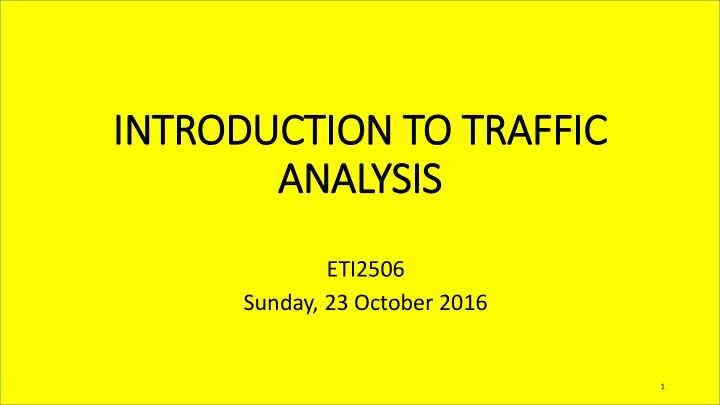

IN INTRODUCTION TO TRAFFIC ANALYSIS ETI2506 Sunday, 23 October 2016 1
WHERE ARE WE IN THE CURRICULUM? 2
GOAL OF TRAFFIC ANALYSIS 1. Except for user terminals, the telephone network is composed of a variety of common 45 Trunks equipment such as call processors and trunks. 30 Trunks 40 Trunks 2. The quantities of the common equipment is usually determined under the assumption that not all users of the telecommunication 30 Trunks network require service at the same time. 50 Trunks 3. The basic goal in traffic analysis is therefore 20 Trunks to provide a method for determining the cost effectiveness of the number of common network equipment and their configurations. 1. Analogue Telephone Network 3
CATEGORIES OF TRAFFIC ANALYSIS Traffic Analysis in a telecommunication system can be divided into two categories depending on how the system treats overload traffic. a) Loss systems where a call attempt is rejected when there are no idle switching resources to handle it. b) Delay systems where call attempts are held in a queue until a facility is available to service them. 4
QUEUE SYSTEMS – EXAMPLE OF LOSS SYSTEM Operating Principle of a Queue: Queue will drop calls if the space allocated is full 5
CONVENTIONAL CIRCUIT SWITCHED SYSTEMS 1. Conventional circuit switched systems are loss systems. 2. Excess traffic is blocked and not serviced without a retry by the user. 3. In most cases the lost calls during blockage represent a loss of revenue by the telecommunications operator. 6
STORE AND FORWARD MESSAGE/PACKET SWITCHING 1. Store and Forward Message/Packet Switching possess the characteristics of a delay system. 2. However, in exceptional cases, packet switched system may have some aspects of a loss system as a result of limited queue sizes and existence of virtual circuits. 7
TRAFFIC FLOW ANALYSIS 1. From the point of view of applied mathematics, a) Blocking probability analysis are studied under congestion theory, and b) Delay probability studies are covered under queuing theory . 2. In telecommunications, these topics usually referred to as traffic flow analysis. 3. Traffic analysis in circuit switched systems is more concerned with the holding times of network facilities rather than the flow of messages in individual circuits. 4. Traffic analysis in message switching and packet switching systems is more concerned with the actual flow of information. 8
RANDOM PROCESSES IN CIRCUIT SWITCHED SYSTEMS There are two underlying random processes in circuit switched networks: a. Call arrivals which occur purely by chance and each users arrival is therefore independent from that of other users b. Holding times of each call which are usually random in circuit switched systems. c. Holding times may be made constant by using fixed length packets in virtual switched networks. 9
ACTIVITY PROFILES OF NETWORKS • Activity profile shows the arrival and holding times of calls in a switched network. • Composite activity shows the number of circuits in use at any one time. 10
TRAFFIC VOLUME 1. A common measure of traffic capacity is the volume of traffic carried over a period of time. 2. Traffic volume is the sum of all holding times in an interval 3. It can be computed by taking the area under the composite activity curve. Composite Activity Time 11
TRAFFIC IN INTENSITY 1. Traffic intensity is represents the average activity during a period of time. 2. It can be obtained by dividing Traffic volume by the length of time during which it was measured. 3. Traffic intensity is measured in erlangs after the Danish pioneer mathematician A.K. Erlang. 4. The maximum capacity of a single server is 1 erlang. 5. The maximum capacity of a group of servers is equal to the number of servers. 6. Traffic Intensity in erlangs can be calculated as 𝐵 = 𝜇𝑢 ℎ Where 𝜇 is the average call arrival and 𝑢 ℎ is the average holding time. 12
THE BUSY HOUR • Telephone traffic is usually analysed based on traffic activity in the busiest hour of the day (commonly referred to as busy hour). • In fixed telephone networks, business telephones generally produce different traffic patterns from that of residential telephones. 13
EXPONTIAL DIS ISTRIBUTION 1. The exponential distribution is used to model the time between the occurrence of events in an interval of time, or the distance between events in space. 2. The exponential distribution is used in telephony to estimate the number of calls arriving in a given time interval. 14
CONDITIONS FOR USING EXPONENTIAL IN INTER- ARRIVAL MODEL The exponential distribution is an appropriate model for modelling inter-arrival period if the following conditions are true. a) Only one call can occur in a sufficiently small interval of time b) The probability of arrival in any sufficiently small interval is directly proportional to the length of the interval c) The probability of arrival at any interval is independent of what has happened in any other previous interval 15
NEGATIVE EXPONENTIAL IN INTER-ARRIVAL 1. The negative exponential inter-arrival model is used to estimate the number of call arrivals in a given interval. 2. It is used in planning to estimate the capacity of a telephone system. 3. If the designate the call arrival in a large group of independent sources as 𝜇 , we can write the probability distribution probability that no arrivals occur in a randomly selected interval of time t as 𝑝 (𝜇 t) = 𝑓 −𝜇𝑢 𝑄 16
WORKED EXAMPLE 5,000 subscriber lines each originate 2 calls per hour. How often do calls arrive with less that 0.1 seconds between them? SOLUTION 2×5,000 𝜇 = = 2.78 arrivals/sec 3600 𝑝 0.278 = 𝑓 −2.78×0.1 = 𝑓 −0.278 = 0.757 𝑄 Therefore 24.3% of calls arrive within 0.1 sec of previous arrival Since the arrival rate is 2.78 per second, this means that this will occur at 2.78 x 0.243 = 0.67554 times/Second 17
Recommend
More recommend